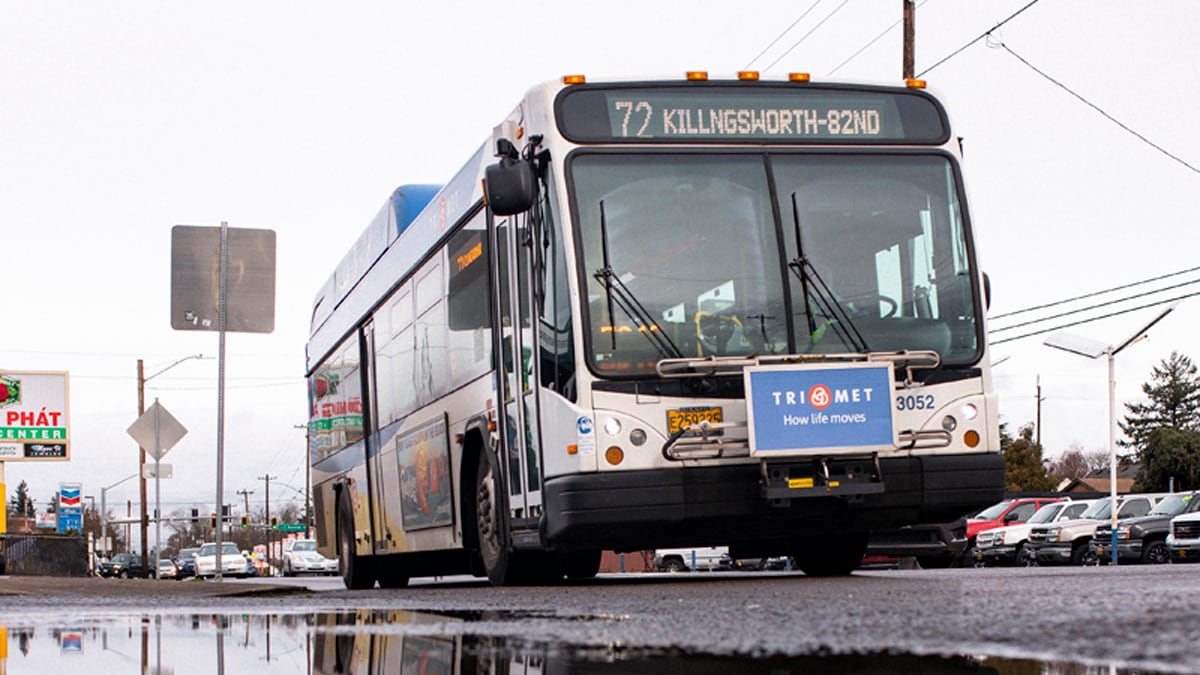Three days a week, Ivy Stamos rises at dawn and boards the most-used bus line in Portland.
Stamos, 25, and her fiance share a car. He prefers to drive: "He's from Texas," she explains. So she often takes the No. 72 bus, part of a 90-minute trip from her home in the Foster-Powell neighborhood to a job answering phones for Portland Public Schools on Northeast Marine Drive, near the the Columbia River.
Except the bus doesn't go that far. Its last stop is three-quarters of a mile shy of her office. She has to walk the rest.
"I don't usually carry an umbrella with me," Stamos says, "so I'm in my jacket trying to keep my head down, but also trying to stay aware of my surroundings so I don't get hit by a car. It sucks."
Portland needs more people to risk puddle-soaked socks and join Stamos on the bus.
Traffic congestion in this city is 10th worst in the nation, says data firm Inrix; drivers spend 116 hours a year stuck in white-knuckled fury. Carbon emissions from Portland transportation—planes, trains and those idling automobiles—rose 8 percent in the past three decades, even as local leaders pledged to fight climate change. Most planners agree there's an obvious fix: Get more commuters aboard public transit.
This year, local governments are debating how big a bet to place on the bus.

In November, regional planning agency Metro will ask voters to approve $3 billion in transportation spending, expected to come from some combination of payroll, income and vehicle taxes. The centerpiece of that spending would be a new light rail line to Tualatin—but hundreds of millions would go to what officials call "enhanced transit," including miles of dedicated lanes on Northeast 82nd Avenue to ensure the No. 72 bus isn't stuck behind cars.
"Metro is doing this because, fundamentally, people need to be able to get to work and school safely and on time," Metro Council President Lynn Peterson tells WW. "We also need to address climate change, reduce pollution, and plan for the new reality that this region is only going to continue to grow. The need is urgent, and the time to act is now."
Here's what the ballot measure won't do: run a bus any closer to Ivy Stamos' place of work. In fact, it won't add any additional bus service anywhere in the city.
Last year, officials with the regional transit agency TriMet advised Metro the proposed measure shouldn't attempt to add bus lines or extend any existing lines, in part because the agency doesn't have enough drivers.
The decision is sparking road rage among advocates who believe the only way to get commuters out of their cars and onto public transit is to make sure riding the bus is nearly as convenient as driving. "Light rail and automotive investments alone won't cut it," says Shawn Fleek, spokesperson for OPAL Environmental Justice Oregon. "Metro can solve for mobility, air quality, and climate goals only if council is courageous enough to push for the necessary increases in bus ridership."

Chris Smith, a member of the Portland Planning and Sustainability Commission who is running for Metro Council on a climate change platform, agrees the measure is insufficient. "We need to change policies to actually achieve reduction in greenhouse gas emissions coming from driving," he says. "We won't succeed unless there's a whole lot more buses."
TriMet says it does have a strategy, unrelated to the ballot measure, to add new lines and extend others. "People come out meeting after meeting, almost begging for more service," says agency spokeswoman Roberta Altstadt. "They want more service, they need more service. It takes coordination, it takes manpower. We're hiring 20 bus operators every three weeks."
Metro says it lobbied the Oregon Legislature in 2017 for the money TriMet is already using for service expansion—and has a different goal this time. "We're asking the voters to make mostly capital improvements to allow the buses to move through traffic and get there on time," says Andy Shaw, Metro's director of government affairs.
Recent figures show just 6.5 percent of the Portland metro region's commutes were aboard public transit. Total bus ridership is flat, even as the city's population skyrockets. Most of the 10 most popular bus lines carried fewer riders last year than five years ago (see graph, page 17). In the past four years, the No. 72 bus that Stamos uses saw a 12.3 percent decline in weekly riders.
So this year, with a $3 billion ballot measure at stake, perhaps the most urgent question in Portland is: What makes people want to ride the bus?
Over the past week, we asked that question to the riders on TriMet's most popular line: No. 72.

The bus travels from the industrial Willamette River harbor on Swan Island to the huge mall at Clackamas Town Center. Along the way, it passes the ice cream shops of gentrified Northeast Alberta Street, ducks beneath Rocky Butte and the Grotto shrine, and runs nearly the entire length of 82nd Avenue—a carnival of used car lots, Asian markets and weed dispensaries.
We rode the 19-mile route, over and over. Along the way, we interviewed more than three dozen riders, including nurses, students, security guards, can collectors, and a guy dousing his peanut butter and jelly sandwich with Tabasco sauce. (OK, to be honest: We left that guy alone.)
We asked the questions that have long surrounded TriMet: How important is a timely bus? Should public transit be free? Should the agency beef up its police presence? And most of all: What would make the commute better?
For Stamos, the answer is easy: "Having a bus that goes all the way to my work."
For others, the answers were more complicated.
We found that riders had varied and nuanced feelings about police, the homeless, ticket prices, and the daily hassles of a bus trip.
Far more than we expected, we found that people viewed the bus as an oasis—a place to decompress and reflect on their day. Most riders we met were the opposite of angry commuters.
Local governments would be wise to listen to them. If voters don't want to ride the bus, they're less likely to pony up billions for transit. And nobody knows what's working on TriMet—and what could make it better—than the people in the seats.

Yareli Razon finished an eight-hour shift at the cash register of Chompers Growlers, a Mexican American diner just off North Marine Drive. Then she waited for the bus. And waited.
"It's not normally on time," says Razon. "Sometimes it's a few minutes late, and sometimes it's more than 15 minutes late. I just want to get home already."
Her top priority for the bus: Show up on time.
TriMet has long battled a reputation for unreliable service. The agency is quick to point to its improved record: 90 percent of buses in the Portland area arrive on time.
But the chief reason buses still run late is something TriMet can't control: traffic.
As local officials try to get commuters out of their cars, their top priority is improving timeliness. In the past year, they've decided that means getting the bus out of car traffic. "If we could add more service all over the place and the buses were flowing, that'd be one thing," Altstadt says. "If we just throw more vehicles in an area that's already congested, those buses would be stuck in the same congestion as everybody else."

Last year, City Commissioner Chloe Eudaly unveiled a plan to dedicate more than 30 miles of road to exclusive bus lanes—mostly by using red paint to mark those lanes as forbidden to cars. This fall, city transportation officials picked 20 roads where bus lanes may be marked with red paint.
The Metro ballot measure also includes bus lanes. The streets picked for such "enhanced transit" avenues include Southwest Tualatin Valley Highway, Southeast McLoughlin Boulevard and 82nd Avenue, part of the route the No. 72 bus follows (see chart, page 16).
Passengers on the No. 72 say they'd welcome it.
"I'm all in favor of a bus lane," says Priscilla Gombach, who works at a Swan Island day care. Gombach, 26, says her commute hinges on a choke point near the Adidas campus in North Portland. (Eudaly's plan might help.)
"That's always where I'm thinking, like, 'Ugh, I need to get to work,'" she says. "I don't know how long I'm going to be, and then if I'm late, my pay is affected. I always worry."
Greg Romach, 47, who says he mostly uses the bus for trips to Starbucks, thinks quantity is more important than punctuality. He wants TriMet to run more buses on the most popular routes—even if one isn't on time, another will be right behind. "Almost like the MAX," he says, "where you don't even need to look at the scheduling, you can just show up and wait. And then in about five minutes or something, the bus will show up."
As for Drew Bolster, a Southeast Portland resident on his way to Clackamas Town Center, "I'd rather see a bike lane." Bolster, 41, rides his bike to work along Southeast 82nd Avenue—but he often has to ride on the sidewalk, because the bike lane either disappears or isn't wide enough to avoid brushes with cars.

John Morolt knows what it's like to be kicked off a bus. He says it's happened to him several times—always because he can't afford the fare.
Morolt, 21, a goateed Hawaiian native, works as a loss-prevention specialist at a Ross department store. Money's tight. He can't always afford to refill his Hop card—the electronic pass to board TriMet's buses and trains. "But the bus drivers are nice enough to let me on," he says.
Morolt is understandably receptive to the idea that public transit should be free. "Right now, of course, the bus is affordable," he says, "but if it's completely free, it'll be less of a worry for those who have to worry so much."
Free fares aren't on the ballot in 2020—except in an indirect way. The leading challenger to Portland Mayor Ted Wheeler, community activist Sarah Iannarone, has campaigned on a platform of eliminating paid fares on TriMet.
Other officials have also called for free fares—including Metro Councilor Juan Carlos González and state Rep. Diego Hernandez (D-East Portland). TriMet general manager Doug Kelsey has repeatedly dismissed the idea, saying it would reduce revenues at an agency that can't afford to give away its core service.

But TriMet itself renewed the public spotlight on fare prices last fall, with an ill-advised attempt at humor on its public service placards. The notices, posted in October, compared fare evasion to skipping out on a bar tab or mooching pizza. An online backlash ensued; the free-fare idea got a little more oxygen.
The policy remains so closely identified with Iannarone that one bus rider, a 23-year-old man from Gresham who called himself Isaac Isaac, brought her up unprompted. "She's not going to change anything," he said. "That's just crazy talk. That's false promises."
No other issue we discussed with riders proved so divisive.
Some people thought free transit was an obvious incentive to increase ridership. Others saw it as madness. A large segment of riders thought fares should be means-tested—free to those who can't afford it—adding to policies TriMet has now, such as a discount for the elderly and disabled called an "Honored Citizen" pass, and a "Youth Pass" for students.
"I would love free bus fare," says a Cully neighborhood baker named Michelle, who declined to give her last name. "If we're really interested in beginning the tasks of reducing our consumption, and climate change, and all those things that are causing us so much misery right now, then to make things egalitarian and accessible is really important."
"Hell, no," says Keith Smith, 55, a manager at DJ's Electrical Inc., who rides the bus to work and back each weekday. "Because if it's free, then everybody—John, Dick and Harry—is going to be riding the bus, all these bums and transients. It'll enrage society if they do it like that. It'll violate the people that are working, and the people that are not working and looking for a job, the high school kids. You'd fill this bus with a whole bunch of transients."

For most of the riders we talked to, the question of fare payment is closely tied to policing, poverty and race. That's because security on TriMet typically comes in the form of inspectors checking fares. And many people suspect those fare inspections profile the homeless and people of color.
Priscilla Gombach, the Swan Island day care worker, isn't sure she wants transit to be free. She worries people won't treat buses and trains with respect—they'll just trash the place. But she doesn't welcome fare inspectors, either.
"Let people just take the bus," she says. "If you're going to check everyone's ticket, you have to make it fair. You can't just randomly pick someone out of the bus. Like, why are you picking that person instead of everybody?"
We asked what was wrong with picking riders at random. "I mean, I'm brown," she replied, with a significant look. "I get it."

It's nice to think of the city bus as a melting pot. But it's more like a pressure cooker. The social tensions of a predominantly white city with a high rate of homelessness and untreated mental illness are on display.
Since May 2017, when Jeremy Christian killed two men who interrupted his racist rant at two black teenage girls, TriMet tried to shake an association between the MAX train and violence. The agency increased security—only to encounter backlash from people of color, who said they were more alarmed by the police than by the possibility of random attacks.
Several riders this week expressed a similar concern. "I sometimes don't feel safe on the bus," said 35-year-old Linnea Solvig, "but I think having a police presence on the bus would make other people feel unsafe."

Others shrugged off safety concerns. Tom Markley, 30, a line cook at Pizza Schmizza, who rides the bus 10 times a week for an 8-mile stretch of 82nd Avenue from Southeast to Northeast Portland, said the worst part of his commute was homeless people trying to talk to him on the bus. But he couldn't see the point of more cops: "It wouldn't help the homeless problem."
Most people said they regularly saw fights or distressing behavior on the bus. "Crackheads, talking to themselves," was how 14-year-old Naomi Williams summarized it. But few felt much alarm, or supported the idea of more security officers. It seemed excessive—especially with a bus driver around to decide who got on.
Michael Collins was among those who said he never felt frightened on the No. 72 bus. But he did feel uneasy at a bus stop once, when he met the Terminator.
"A gentleman introduced himself as the Terminator," Collins recalled. "He said, 'Do you ever feel like you were put on this earth to kill people?' I said, 'Not recently, no.' And then the bus came two minutes later, so it was OK."

Gabrielle Dorn struggled to think of the worst thing she'd seen on the bus.
"Actually, not much," said Dorn, 34, a hospital worker. "I've smelled a lot of drugs on people—like pot. But it's Portland."
Her response was part of a pattern we encountered on the No. 72. Most riders were happy. Many of them compared Portland's public transit system to that in other cities—San Francisco, Philadelphia and Washington, D.C.—and said here was better. Some said they couldn't think of a single thing they wanted to change.
Those responses bode well for Metro as it prepares to ask voters for a $3 billion cash infusion for regional transportation. People who ride the bus like the bus. Their opinion matches those in TriMet's own customer satisfaction surveys. "Riders generally have a more positive perception of the job that TriMet does than non-riders," Altstadt says. "Non-riders tend to get their information thirdhand, so they don't have that perspective."
At the same time, there's a reason for local officials to be wary: No urgent need galvanized the riders we talked to. They didn't have a cause they rallied around. Certainly, they weren't inspired by the thought of a light rail line to Tualatin: Only two people mentioned it.
"I think everything's fine the way it is," said Konane Soto, 17, a student at the NAYA Family Center, when we asked him about bus-only lanes.

In some ways, that confusion matches the patchwork measure Metro has produced, which feels designed by committee. (It was.) But the complacency of riders suggests a momentum problem. Nobody we encountered riding TriMet is demanding change. Other issues, including the explosion of homelessness, threaten to crowd buses and trains out of the public imagination.
As Portland voters weigh the urgency of a huge transportation measure, the humble bus could use a few more evangelists. Portland may need more people riding the bus. But it's one thing to tell people they need something and another thing for them to want it.
Ivy Stamos sees that disconnect. "A lot of the people I work with, who take cars or ride their bike, whenever I tell them about my commute, they're always super-shocked and say, 'I'll never ride a bus because of A, B and C,'" Stamos says. "It's either they think it's dirty, or unsafe, or the people they encounter are untrustworthy, or they get grossed out about it."
She doesn't see it that way. "But also," she adds, "I've never had a car until two years ago."

82nd Times 5
Metro's planned transportation funding measure would dole out money to 13 selected roads as "corridor investments." Northeast and Southeast 82nd Avenue is one of those roads. Final design won't be complete until after the measure is referred to voters, because Metro plans to conduct an environmental review process as part of an effort to win federal funding for the project. But here are five ways the avenue could improve.

$200 million for bus lanes, traffic signals that give priority to buses, and other bus improvements.

Up to $251 million for wider sidewalks, better crosswalks, and more lighting to improve safety along 9 miles of 82nd.

$30 million to pave the road, fix potholes and add wheelchair ramps to curbs to meet a state of "good repair."

Up to $1.5 million to improve the 82nd Avenue MAX light rail station.

$35 million to widen Airport Way at the north end of 82nd.

Flat Tires
Fewer passengers ride the No. 72 bus now than in 2016. That's part of a larger pattern: Over the past four years, most of TriMet's 10 most-used bus lines have seen stagnant or declining weekly ridership. The agency says the exceptions—such as the No. 6 line, which runs up and down Martin Luther King Jr. Boulevard—benefited from added service and extended or adjusted routes.




